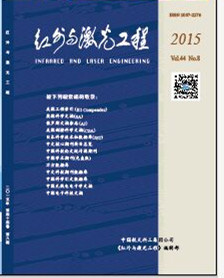|
[1]
|
Novotny V. Application of nonaqueous colloids[J]. Colloids and Surfaces, 1987, 24: 361-364. |
|
[2]
|
Liu Jingchun, Han Jiancheng. Application of the cross century high-tech materials of nano SiO2[J]. The New Type Material of Chemistry Engineering, 1998, 7: 3-6. |
|
[3]
|
Blanco A, Chomski E, Grabtchak S, et al. Large-scale synthesis of a silicon photonic crystal with a complete three-dimensional band gap near 1.5 micrometers[J]. Nature, 2000, 405(6785): 437-440. |
|
[4]
|
Schroden R C, A1-Daous M, Blanford C F, et al. Optical properties of inverse opal photonic crystals[J]. Chemistry of Materialsl, 2002, 14(8): 3305-3315. |
|
[5]
|
Jiang P, Bertone J F, Colvin V L. A lost-wax approach to monodisperse colloids and their crystals[J]. Science, 2001, 291(5503): 453-457. |
|
[6]
|
Velev O D, Jede T A, Lobo R F, et al. Porous silica via colloidal crystallization[J]. Nature, 1997, 389(6650): 447-448. |
|
[7]
|
Brain T Holland, Christopher F BLanford, Andreas Stein.synthesis of macroporous minerals with highly ordered three-dimensional arrays of spheroidal voids[J]. Science, 1998, 281(5376): 538-540. |
|
[8]
|
Velev O D, Tessier P M, Lenhoff A M, et al. Materials: A class of porous metallic nanostructures[J]. Nature, 1999, 401(6753): 548. |
|
[9]
|
Li Zhiyuan, Zhang Zhaoqing. Fragility of photonic band gaps in inverse-opal photonic crystals[J]. Phys Rev: B, 2000, 62: 1516-1519. |
|
[10]
|
Wang Zengbo, Guo Wei, Li Lin, et al. Optical virtual imaging at 50 nm lateral resolution with a white-light nanoscope[J]. Nat Comm, 2011, 2: 218-223. |
|
[11]
|
George M Whitesides, Bartosz Grzybowski. Self-assembly at all scales[J]. Science, 2002, 295: 2418-2421. |
|
[12]
|
Mackay Michael E, Tuteja Anish, Duxbury Phillip M, et al. General strategies for nanoparticle dispersion[J]. Science, 2006, 311: 1740-1743. |
|
[13]
|
Lee B I, Rives J P. Dispersion of alumina powders in nonaqueous media[J]. Colloids and Surfaces, 1991, 56: 25-27. |
|
[14]
|
Lange F F. Powders processing science and technology for increased reliability[J]. J Am Geram Soc, 1989, 72(1): 3-15. |
|
[15]
|
Norris D J, Arlinghaus E G. Opaline photonic crystals: how does self-Assembly work[J]. Advance Materials, 2004, 16: 1393-1399. |
|
[16]
|
Chen L, Dong P. Diffusion coefficient of petroleum residue fractions in a SiO2 model catalyst[J]. Ind Eng Chem Res,2009, 23(6): 2862-2866. |
|
[17]
|
Hao Xiang, Kuang Cuifang, Li Yanghui. Hydrophilic microsphere based microscopic-lens microscope[J]. Opt Commun, 2012, 285: 4130-4133. |
|
[18]
|
Kuang Cuifang, Liu Yong, Hao Xiang, et al. Creating attoliter detection volume by microsphere photonic nanojet and fluorescence depletion[J]. Opt Commun, 2012 285: 402-406. |
|
[19]
|
Ku Yulong, Kuang Cuifang, Hao Xiang, et al. Superenhanced three-dimensional confinement of light by compound metal-dielectric microspheres[J]. Opt Express, 2012, 20(15): 16981-16991. |
|
[20]
|
Yokoyma T, Huang C C. Nanoparticle technology for the production of functional materials[J]. KONA, Powder and Particle, 2005, 23: 7-17. |
|
[21]
|
Michael E Mackay, Anish Tuteja, Phillip M Duxbury, et al. General strategies for nanoparticle dispersion[J]. Science, 2006, 311(5768): 1740-1743. |
|
[22]
|
Zhu Y P, Xu L L, Li C F. Research progress of nanoparticle agglomeration[J]. Journal of Tianjin Medical University, 2006, 11(2): 338-341. |
|
[23]
|
Pampuch R, Haberko K. Agglomerate in Ceramic Micropowders and their Behaviour on Cold Pressing and Sintering[M]. Amsterdam: Elsevier Scientific Publishing Company, 1983, 16: 623-634. |
|
[24]
|
Kim J U, O'Shaughnessy B. Morphology selection of nanoparticle dispersions by polymer media[J]. Phys Rev Lett, 2002, 89(23): 238301-1-238301-4. |
|
[25]
|
Cui H M, Liu H, Wang J Y, et al. Agglomeration and disperasion of nano-scale powders[J]. Materials for Mechanical Engineering, 2004, 28(8): 38-41. |
|
[26]
|
Li Z H, Li F Q, Ma P H. Elimination methods and mechanism of agglomeration of ultrafine powders[J]. Journal of Salt Lake Research, 2005, 13(1): 31-36. |
|
[27]
|
Lei L, Lu N N, Wu M H, et al. De-aggregation of nano-TiO2 soft agglomeration in aqueous medium[J]. CIESC Journal, 2009, 60(12): 3159-3163. |
|
[28]
|
Huang Suping, Zhang Qingcen. Dispersion mechanism of ultrafine silica[J]. The Chinese Journal of Nonferrous Metals, 2001, 11(3): 522-526. |
|
[29]
|
Zhang Qingcen, Huang Suping. Effect of non-ionic dispersants on the stability of colloidal silica[J]. Multipurpose Utilization of Mineral Resources, 2001, 4: 15-18. |
|
[30]
|
Ren J, Lu S C. Effect of dispersion of dispersant on particles in water media[J]. Journal of University of Science and Technology Beijing, 1998, 20(1): 7-10. |
|
[31]
|
Yuan Yan, Zhang Rui, Qi Dongming, et al. Deaggregation behavior in the dispersion process of silica soft aggregation into ethanol media[J]. Journal of Zhejiang Sci-Tech University, 2011, 28(4): 485-489. |









 DownLoad:
DownLoad: